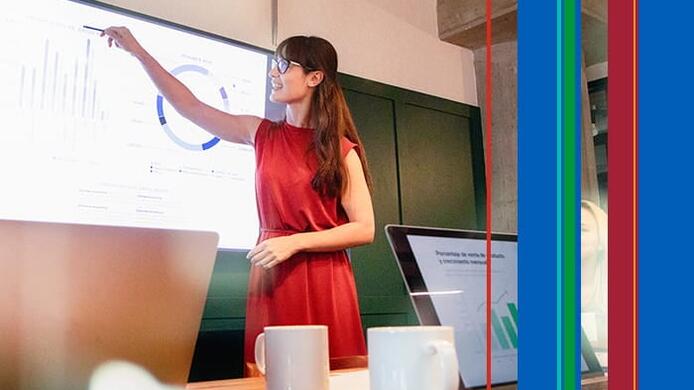Explore our resources for educational leadership degrees, from master's to doctorates, and learn about career options that fit your future.

What does innovation mean to you? Is it simply an overused buzzword or does it provide inspiration for advancement? As technology evolves at light speed, innovation impacts all aspects of the economy, including how we learn. Here we explore five innovative trends in today's landscape of higher education.
Top Trends Transforming Higher Education
Integrating Systems Thinking
The concept of systems thinking is often part of the graduate-level curriculum in many leadership and business classes, but it is starting to gain traction in the world of education as well. Some schools, like University of Massachusetts Global and its School of Education, offer doctoral degrees in organizational leadership, but it is not a concept that naturally comes to mind from a public perspective when considering innovative education tactics. This is changing in the landscape of higher education with an industry call to action to redefine quality in terms of learning outcomes and fully linked curriculum.
Keynote speaker Jaime P. Merisotis, the president of Lumina Foundation, addressed this issue at the State Higher Education Executive Officers Association (SHEEO) annual meeting in July. She stated in her speech that, "The institutional focus - the idea that decisions and funding and policies should respond to the needs of colleges and universities - must be replaced by a focus on meeting the needs of students, and, by extension, the needs of society." This addresses the need for higher education in general to focus on learning outcomes as a true measure of a quality degree.
The integrated approach comes into play when administrators and educators alike realize that a student-centered approach promotes a fully linked system at all levels. This includes pre-K, through higher ed, into the workforce and beyond. Merisotis points out that once this shift is made, it becomes possible to take other vital steps such as:
- Aligning assessments and certifications at various levels of education to prevent duplication and improve timely completion of programs.
- Creating and refining financial aid programs and funding models that incentivize actual outcomes - paying students and institutions for what is actually learned rather than the time it takes to complete tasks
- Clearly defining career ladders and pathways for students to follow
- Assuring employers that graduates will have the knowledge and skills they truly need to succeed in the modern workplace, and better understand from employers what they are looking for
These are just some factors that are beginning to gain momentum within the world of higher education and society as a whole. Some solutions outlined include online education programs that are assessment-based learning at all levels. Read Jaime P. Merisotis's full speech on the Lumina Foundation website.
Man vs. Machine
Blockbuster hits such as the Terminator series and iRobot address this theme over and over again. Man versus machine, which is more powerful? It is evident that the industrial age has passed, the Silicon Valley bubble has burst and now, in the digital age, we have advanced to information as king. This can be Utopia for academia in that the amount of knowledge one can gain is nearly endless, but the world of education now faces another issue - keeping up with the same digital advances that man has created.
Christine Lagarde, the managing director of Stanford University's international monetary fund, spoke last week on how education can advance the global economy. She explains that education is the bridge that can take us to the future we want by leveraging technology as a learning platform.
In many industries, we build programs that can replace humans in specific job areas. This may create efficiencies but can also have a negative effect on the economy. The message here is to have academia think strategically about how to balance man and machine. Lagarde says:
"A 21st century educational system must focus on the areas where humans can outclass computers—such as in cognitive skills, interpersonal skills, fine motor skills, or sophisticated coding skills. Think of creative jobs, caring jobs, jobs that entail great craftsmanship. And given the rate and pace of change, we will need the ability to constantly adapt and change through lifelong learning. Yes, machines can replace our muscles. Computers may even replace our intelligence. But they can never replace the capacities that make us truly human: our creativity and innovation, our passion."
This inspiring statement portrays the perfect balance of powers. Institutions of higher education must think hard about how to equip today's generation for tomorrow's realities. Public and private sectors need to work closely together to provide the feedback needed to shape teachings to adapt to workforce demands. Educators need to reevaluate their standards of how, why, when and what people learn and leverage technologies to facilitate learning. Expect digital learning platforms to become more prominent throughout all levels of academia to adapt to this call to action. Learn more by reading Christine Lagarde's full speech.
Creating Sustainable Communities
Sustainability is beginning to root itself into the fabric of society. A few years ago, it may have been considered a buzzword or perceived in relation to a public relations stunt, whereas now the principles are becoming public norms. Our third trend focuses on creating economically sustainable cities through higher education.
Harvard professor and economist Edward Glaseser found a direct correlation between thriving cities and post-secondary education. His studies prove that as the share of the population with college degrees increases by 10 percent, per capita gross metropolitan production rises by 22 percent. Given this significant statistic, the Lumina Foundation has launched a new initiative that unites educational and civic leaders to create sustainable solutions for American communities.
The goal of the movement is simple – increase the percentage of high-quality certificates, associate degrees and bachelor’s degrees held by local residents. Twenty communities across the country were initially selected to participate based on their recent momentum and motivation to graduate more students. Although it is an economic matter, the core of the initiative is to empower people and create smarter cities, and ultimately a stronger nation through higher education. These well-educated citizens may also contribute to building eco-friendly systems within the community to advance ecological efforts worldwide.
There are plans to expand the initiative to other cities in 2014 and beyond. In Jamie Merisotis’ HuffPost article, he describes the initiative in more detail and mentions, “Communities that focus and invest in higher education, keeping the talent they have and bringing even more educated people in, will have far greater chances of being competitive, vibrant places to live and work.”
Blending Traditional and Nontraditional Education
What are the true differences between traditional and nontraditional education experiences? Quite honestly, the line separating the two columns is beginning to fade away.
In a general sense, many for-profit schools like University of Phoenix, DeVry and Kaplan portray images of the typical nontraditional learning environment. This segment of academia was founded specifically to provide flexible options for working adults with classes available after hours to fit into busy schedules. They were among the first to offer fully online programs which have evolved drastically in recent years.
When we think of the traditional education environment, the scene falls somewhere between historic Ivy League sites and die-hard sports arenas filled with fans bleeding school colors. Arizona State University and University of Pennsylvania are often categorized as traditional institutions complete with near endless student life activities, on-site dormitories and brick and mortar libraries. But now, with both schools offering undergraduate and graduate degrees fully online, they have broken barriers, welcoming nontraditional students into their circles.
This movement represents a significant shift in higher education. It helps make education more accessible, and in some cases, more affordable. The online element can have a positive effect on expanding community involvement and enhancing diversity by bringing in students from across the country and even across the world.
The prestigious Chapman University in Southern California was at the forefront of this movement over 50 years ago when they expanded their main campus to include satellite campuses. These locations were placed directly on military bases, providing quality education to armed service members who could not attend the traditional four-year school. Today, the network of campuses makes up University of Massachusetts Global, a private nonprofit school educated on the success of nontraditional students. This is a perfect example of how blending the lines can benefit the evolution of higher education.
Assessing and Awarding Competence
Many of the concepts you have read about thus far encompass the idea of connecting education systems with the needs of the workforce. In an attempt to solve the problems facing higher education, late last year President Obama announced a plan to promote innovation and competition in the industry. The ideal landscape would provide Quality academic programs at Affordable prices to increase Accessibility to education.
There are three core action items that the White House asks universities and colleges to take in the near future. It calls for institutions to:
- Award credits based on learning rather than seat time
- Leverage technology to redesign courses
- Recognize prior learning and work experience
One of the results of this call to action is the idea of competency-based learning. Dr. Charles Bullock, Executive Vice Chancellor of Academic Affairs and Chief Academic Officer at University of Massachusetts Global, says this platform is “focused on student demonstration and mastery of knowledge, skills and abilities (collectively called competency) – or what employees know and can do in the workplace – rather than on how many hours, semesters, or years a student spends in college.”
Data and assessment are at the core of competency-based education (CBE). Students can set their own pace of learning and often speed up their time to graduation. Many of the learning platforms, like UMass Global MyPath™, utilize techniques such as adaptive learning, gamification through real-world simulations, and instruction on demand. Some schools, such as Western Governor’s University and Southern New Hampshire University, have already implemented CBE programs and others are already following suit. The initiative will continue to gain momentum and ultimately transform the world of higher education.








